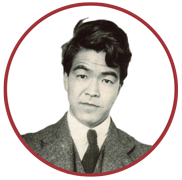This exhibition presents the extant correspondence--nearly all unpublished--between Bernard Berenson and Yukio Yashiro. At the height of their fame they were among the most influential art historians in the West and in Japan, respectively. Today Yashiro is little known outside of his native country except for his monograph on Botticelli, published in English in 1925, now available on this website. Yashiro described his goals for the book in a remarkable letter from 1922 to Laurence Binyon: “I shall make clear what I, a man brought up in an artistic atmosphere utterly different from that of Europe, feel of Botticelli, that side of Botticelli which, as I think, was never, or perhaps very little, appreciated by European connoisseurs.”* It was Binyon who introduced Yashiro to Berenson in 1921, as discussed in the Director's preface. Only six years after the completion of his library, which celebrates its 100th anniversary this year, Berenson provided the young scholar with advice, encouragement, and scholarly resources.
In his fascinating but virtually unknown autobiography, My Life in the Fine Arts (1972), partially translated for this exhibition, Yashiro provided the perspective of a Japanese scholar on the Italian art history world during "an era that bustled with activity...the first twenty or thirty years of the twentieth century, when the traditional history of Italian painting was almost entirely rewritten." He described the "competition for new discoveries...It was like we were completely engrossed in racing to the front of the pack." Yashiro recounted an event generally overlooked in the literature on Domenico Veneziano, when he was the first to correctly attribute the now celebrated Annunciation in the Fitzwilliam Museum. "Seeing as how a young newcomer from the East had begun to make such brazen pronouncements out of the blue," he wrote, the director, Sydney Cockerell seemed bewildered. It was Cockerell, however, who made sure that Yashiro received proper credit for his discovery. The intriguing story is revealed in Cockerell's unpublished letters to Berenson.
In his autobiograpy, Yashiro speculated on the reasons why Berenson gave him such a warm welcome: “perhaps it was because I was the only Asian among Mr. Berenson’s disciples and his extraordinarily broad field of interest also included Eastern art.” Articles by Michael Gorman and Carl Strehlke explore this interest. It also permeates Berenson's dedication to the Japanese edition of his Italian Painters of the Renaissance (1954), written in the form of a letter to Yashiro:
In the field of Italian art you have produced the most authoritative, the most illuminating and the most readable book on Botticelli in any language. Botticelli’s swift flame-like yet modelling line is almost unique in European art but I have encountered it frequently in Japanese drawings. Indeed there is a great affinity between the draughtsmanship of Florentine and Japanese artists. Thanks to you, my dear Yashiro, we Europeans have come to have subtler and more penetrating appreciation of the achievement of your countrymen and they of ours.
In My Life in the Fine Arts, Yashiro took his distance from Berenson’s views on the Eastern quality of Botticelli’s art. In 1952, the Asian scholar published his own analysis of "The 'Oriental' Character in Italian Tre- and Quattrocento Paintings." The article represents something of an exception among Yashiro’s mature writings. After he completed his Botticelli studies in the 1920s, Yashiro devoted himself almost entirely to the study of Asian art, as discussed by Akira Takagishi. This leads to a second major theme in his letters to Berenson, one explored by Emiko Yamanashi: his establishment of the Institute of Art Research in Tokyo, in 1930, and subsequent directorship of this important center. In letters to his mentor, Yashiro explains how at this Institute he introduced the methods he had learned at I Tatti: careful stylistic analysis carried out with the auxiliary of a photo archive. Unbeknownst to most scholars today, Berenson had a direct and lasting impact on how Japanese scholars study Japanese art in Japan.
Michiaki Koshikawa's introduction to Yashiro’s letters provides succinct, engaging summaries of a half-dozen more themes found in his correspondence with Mary and Bernard Berenson, ranging from the professional to the personal. These missives reveal the depth of the friendship and respect shared by these scholars. As aptly noted by Yashiro’s daughter-in-law in her moving letter, “encountering a benevolent mentor can be called one of the treasures of human life, and indeed, Berenson remained Yashiro’s most revered teacher throughout his life.”
This exhibition is the result of an international collaboration between three institutions closely associated with Berenson and Yashiro: Villa I Tatti - The Harvard University Center for Italian Renaissance Studies, Florence (founded by Berenson), as represented by co-curator Jonathan Nelson, Assistant Director for Academic Programs and Publication; the National Research Institute for Cultural Properties, Tokyo (founded by Yashiro as the Institute of Art Research), as represented by co-curator Emiko Yamanashi, Director of the Department of Art Research, Archives and Information Systems; and Tokyo University of the Arts, Department of Aesthetics and Art History (formerly Tokyo Fine Arts School, where Yashiro first taught European art history), as represented by co-curator Michiaki Koshikawa, Professor of Art History. For the acknowledgements from the co-curators, please see the colophon.
Jonathan K. Nelson
***
* For the transcription of this unpublished letter I thank John Trevor Hatcher, who mentions it in his article on "Anglo-Japanese Friendships: Yashiro Yukio, Laurence Binyon and Arthur Waley."

